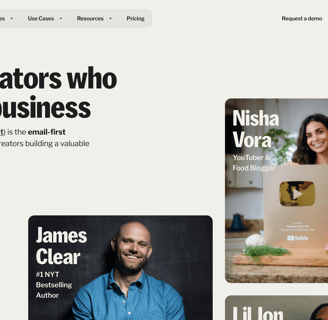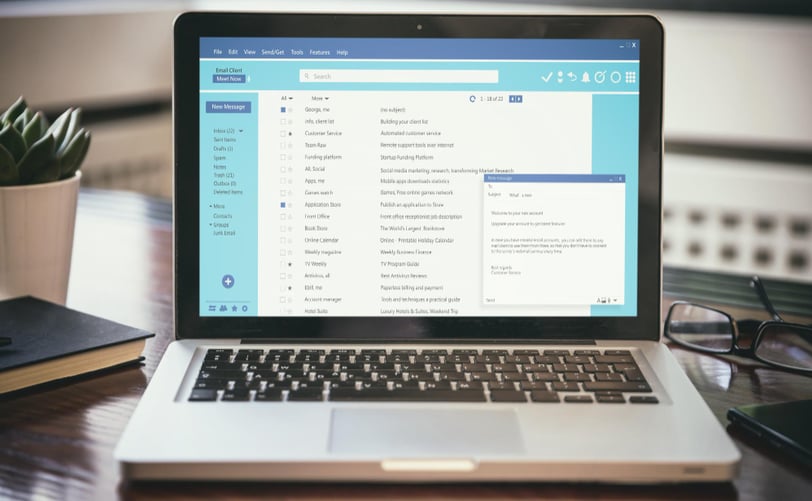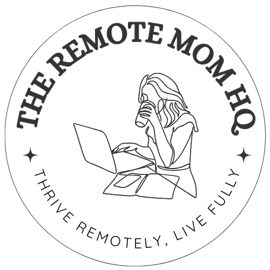
Email Writing Tips: How to Write Conversational Emails That Actually Get Read
* This post contains affiliate links. If you click through and make a purchase, I may earn a small commission at no extra cost to you. Thank you for supporting The Remote Mom HQ!
TABLE OF CONTENTS
Why "Normal" Email Writing Feels So Weird
The "Friend Text" Method
The Template That Actually Works
Making It Even Easier with the Right Tools
The "Oops, I'm Human" Moments
What Not to Worry About
The Magic Formula for Subject Lines
How to Know What to Write About
Making the Tech Part Less Overwhelming
The Secret to Getting People to Actually Click
When Things Don't Go Perfect
Your First Email Challenge
The Long Game (Why This Actually Works)
Okay, so you're staring at that blank email draft in your email platform, cursor blinking at you like it's judging your life choices, and you're thinking "how am I supposed to write something that doesn't sound like a robot trying to sell car insurance?" Yeah, I totally get it.
Here's the thing - you don't need to be some fancy copywriter with a degree in persuasion psychology or whatever. You literally just need to write like you're texting your best friend about something you're genuinely excited about. That's it. That's the whole secret, and I'm about to break down exactly how to do it.
Why "Normal" Email Writing Feels So Weird
So here's what happens, right? You sit down to write an email to your subscribers, and suddenly your brain goes into this weird "professional business mode" where you start using words like "utilize" instead of "use" and "facilitate" instead of "help." Like, who are you trying to impress here?
The truth is, people get enough corporate-speak emails every single day. Their inboxes are literally drowning in "We hope this email finds you well" and "Please don't hesitate to reach out." Ugh, even typing that made me feel sleepy.
What people actually want - what makes them stop scrolling and actually READ your email - is feeling like a real human being is talking to them. You know what I mean? Like when your friend texts you about this amazing thing they just discovered and you can practically hear their excitement through the screen.


The "Friend Text" Method
Alright, so here's my favorite trick for writing emails that people actually want to read. I call it the "Friend Text" method, and it's basically exactly what it sounds like.
Before you write your email, imagine you're texting your best friend about whatever you want to share. Like, literally imagine it. What would you say? How would you say it? Would you start with "I hope you're having a productive Tuesday"? No way. You'd probably jump right into the good stuff.
Here's how it works:
Instead of: "I wanted to reach out and share some valuable insights about productivity strategies that could potentially enhance your daily workflow..."
You'd text: "So, I figured out this thing that's literally saving me like 2 hours every day and I had to tell you about it..."
See the difference? The second one makes you want to keep reading, right?
The Template That Actually Works
Okay, so I'm about to give you a super simple template that you can literally copy and paste and just fill in your own details.
Subject Line Formula: Keep it short and curious. Think "wait, what?" instead of "URGENT: READ THIS NOW!!!"
Examples:
"This productivity hack is kinda weird but..."
"Quick question about your morning routine"
"The thing nobody talks about with working from home"
Email Structure:
Opening (2-3 sentences max): Jump right into what you're thinking about. No "hope you're well" nonsense.
"So I was making coffee this morning and had this random thought about why some days feel completely chaotic and others feel totally manageable..."
Main Content (3-4 short paragraphs): Share your point like you're explaining it to a friend. Use "you know what I mean?" and "here's the thing" and all those natural conversation bridges.
"Here's what I realized - it's not actually about having more time. It's about having systems that work even when everything goes sideways (which, let's be honest, happens approximately every day when you're a mom, right?)"
The Soft Ask: Don't be salesy. Just mention the thing naturally, like you'd recommend a good restaurant. I know I hate to be sold at EVERY SINGLE TIME. Right?
"Speaking of systems that actually work, I've been using ConvertKit to organize all my email stuff and honestly? It's made this whole email thing so much less overwhelming. Like, I can literally write one email and it looks professional without me having to figure out fancy formatting or whatever." (Psst! I actually started exploring ConvertKit for a client’s email marketing.)
Closing: End like you'd end a text conversation. Casual, maybe a question.
"Anyway, what's one system that's actually working for you lately? I'm always looking for new ideas! Talk soon! [Your name]"
Making It Even Easier with the Right Tools
So here's where I'm going to be real with you - having a good email platform makes this whole thing SO much easier. Like, you can focus on just writing naturally instead of wrestling with technology.
The thing I love most about Kit (ConvertKit) is that it doesn't make you feel like you need to be some marketing genius. The interface is super clean and simple - you can literally just start typing and it works. Plus, their templates are actually designed for real people, not corporate newsletters that nobody reads.
What makes Kit perfect for this friendly email approach:
The editor feels like writing in a Google doc, not some complicated marketing platform
You can see exactly how your email will look on phones (because let's be real, that's where people read emails)
It handles all the technical stuff automatically so you can focus on just being yourself
The analytics actually make sense - you can see what people liked without needing a marketing degree
You can start a free trial if you would like to test out Kit. But I’m sure you’ll find it easy to work with and into your home-based business.


The "Oops, I'm Human" Moments
Here's something most people won't tell you - the moments when you're most human in your emails are often the moments that get the best response. Like when you make a typo and acknowledge it, or when you go off on a little tangent and then bring it back.
"Okay, I totally just went down a rabbit hole about coffee makers (my current obsession, don't judge), but here's why this actually relates to what I was saying about email writing..."
People LOVE these moments because it reminds them there's a real person behind the email. It's like when you're having a conversation with someone and they pause and say "sorry, I'm rambling" - it actually makes you feel more connected to them.
What Not to Worry About
Can I just say something that might take some pressure off? You don't need to be perfect. You don't need every email to be this masterpiece of marketing brilliance. Sometimes the emails that perform best are the ones where you're just sharing something you're genuinely excited about or asking a simple question.
Stop worrying about:
Perfect grammar (seriously, contractions and casual language are fine)
Following some complicated email formula you read somewhere
Making every email have some big revelation or call-to-action
Sounding "professional" (whatever that means anyway)
Focus on:
Being genuinely helpful or interesting
Writing like you talk
Sharing things you actually care about
Asking questions you're curious about
The Magic Formula for Subject Lines
Okay, so subject lines are kind of important because if people don't open your email, it doesn't matter how amazing it is inside, right? But here's the thing - you don't need to be clickbait-y or weird about it.


The best subject lines feel like:
A friend texting you something interesting: "Wait, did you see this?"
The beginning of a conversation: "Quick question about morning routines"
Something that makes you curious but not annoyed: "This productivity thing is kinda weird but..."
Avoid the icky stuff like:
ALL CAPS EVERYTHING
Too many emoji (one is fine, seven is not)
Fake urgency (URGENT! EXPIRES TODAY!)
Generic business-speak (Newsletter #47: Updates and Insights)
How to Know What to Write About
So you might be thinking "okay, this all sounds great, but what do I actually write about?" And honestly? The best email content comes from just paying attention to your regular life.
What are you figuring out? What's working for you lately? What's frustrating you? What did someone ask you about that made you think "oh, other people probably wonder about this too"?
Like, maybe you discovered that doing email writing in the morning works better for you than trying to do it at night when your brain feels like mush. That's an email right there. Or maybe you realized that ConvertKit's automation features are saving you time in ways you didn't expect. Share that.
Email topic ideas from real life:
"Why I stopped trying to write perfect emails (and started getting better responses)"
"The email tool that's actually making my life easier (not sponsored, just genuinely helpful)"
"Three things I wish I knew before I started email marketing"
"Quick question - how do you decide what to write about?"
Making the Tech Part Less Overwhelming
Look, I'm going to be honest with you - I'm not super tech-savvy. Like, at all. When I first started with email marketing, I was literally intimidated by everything. All the platforms looked so complicated, and I was worried I'd break something or send an email to the wrong people or whatever.
But here's what I learned - you don't need to understand every single feature from day one. You literally just need to be able to write an email and send it to people who want to read it. That's it.
ConvertKit has been perfect for this because it doesn't assume you're some marketing expert. When you log in, it's pretty obvious what you need to do. You write your email, you pick who gets it, you send it. Done.
The broadcast editor specifically is designed for people like us who just want to write naturally without having to think about HTML code or complicated formatting. You can literally just type like you're writing in a Word document, and it handles making it look good.
The Secret to Getting People to Actually Click
Okay, so here's something I learned by accident - the best way to get people to click on things in your emails is to not be weird about it. Like, don't suddenly shift into sales mode in the middle of your friendly email.
Instead of: "Click here to learn more about this amazing productivity solution that will transform your life!"
Try: "I've been using this thing called ConvertKit for my email stuff, and it's honestly made everything so much simpler. If you're curious about it, you can check it out here - no pressure though!"
See how the second one feels like a friend recommending something instead of an ad? That's what gets clicks. People can sense when you genuinely think something is helpful versus when you're just trying to sell them something.
When Things Don't Go Perfect
Can we just acknowledge that sometimes you're going to send an email with a typo, or you'll realize after you hit send that you forgot to mention the main thing you wanted to say? It happens. To everyone. Even the people with the fancy marketing degrees.
The beautiful thing about the conversational email approach is that these moments actually make people like you more. You can literally send a follow-up email that says "Okay, so I just realized I completely forgot to mention the most important part..." and people will think it's charming.
I've seen emails perform better after someone sent a quick "oops, here's what I meant to say" follow-up. It's like when you're talking to someone and you interrupt yourself to clarify something - it makes the conversation feel more real and connected.
Your First Email Challenge
Alright, so here's what I want you to do. Don't overthink this. Just pick something - anything - that you've been thinking about lately that might be helpful or interesting to someone else.
Maybe it's a productivity tip, or a tool that's working for you, or even just a question you've been wondering about. Write it like you're texting a friend about it. Give yourself 15 minutes max.
Use ConvertKit's broadcast editor (seriously, it makes this so much easier), and just write naturally. Don't worry about it being perfect or having some big marketing strategy behind it. Just be helpful and human.
Your email checklist:
✓ Subject line that makes you curious (not salesy)
✓ Opening that jumps right into what you're thinking about
✓ Main content that feels like a conversation
✓ Natural mention of anything you want to recommend
✓ Casual closing with maybe a question
That's literally it. You don't need anything fancier than that.
The Long Game (Why This Actually Works)
Here's the thing about writing emails that feel like friendly chats - it builds something that all the fancy marketing tactics in the world can't buy: actual trust and connection.
When people feel like they know you through your emails, when they look forward to hearing from you, when they feel like you're genuinely trying to be helpful instead of just selling them stuff... that's when the magic happens. That's when people actually want to support you and try the things you recommend.
It takes a little longer than the "URGENT BUY NOW" approach, but it builds something real and sustainable. Plus, it's so much more fun to write emails when you're just being yourself instead of trying to be some marketing robot.
The bottom line: You already know how to have conversations with people you care about. Email marketing is literally just that - having conversations with people, but through email instead of in person.
So stop making it harder than it needs to be. Use tools like Kit (ConvertKit) that make the technical stuff simple, write like you talk, and focus on being genuinely helpful. The rest will figure itself out.
Trust me on this one. Sometimes the simplest approach is actually the most effective approach. And honestly? It's way more fun too.
Thrive Remotely, Live Fully. ✨
